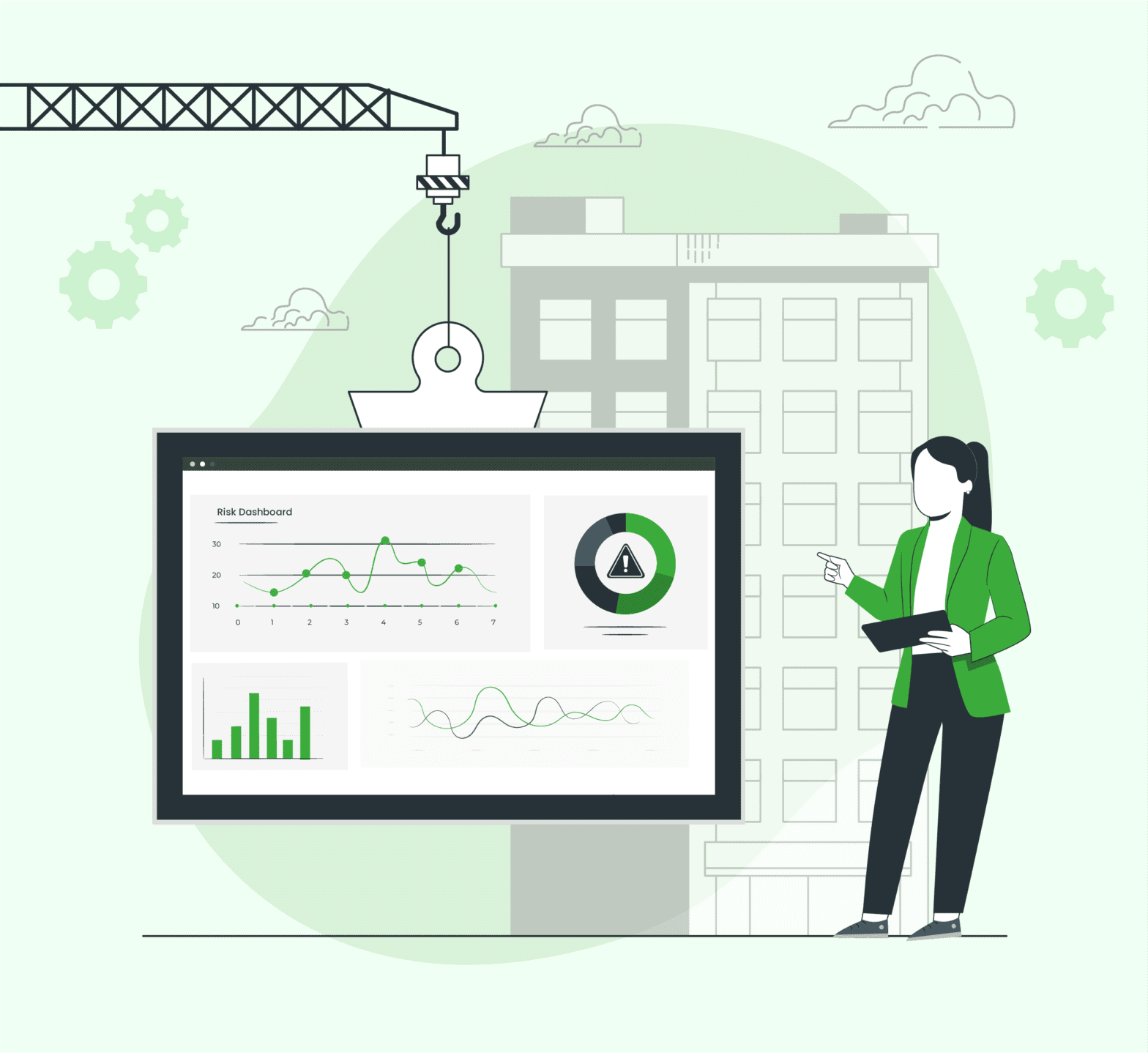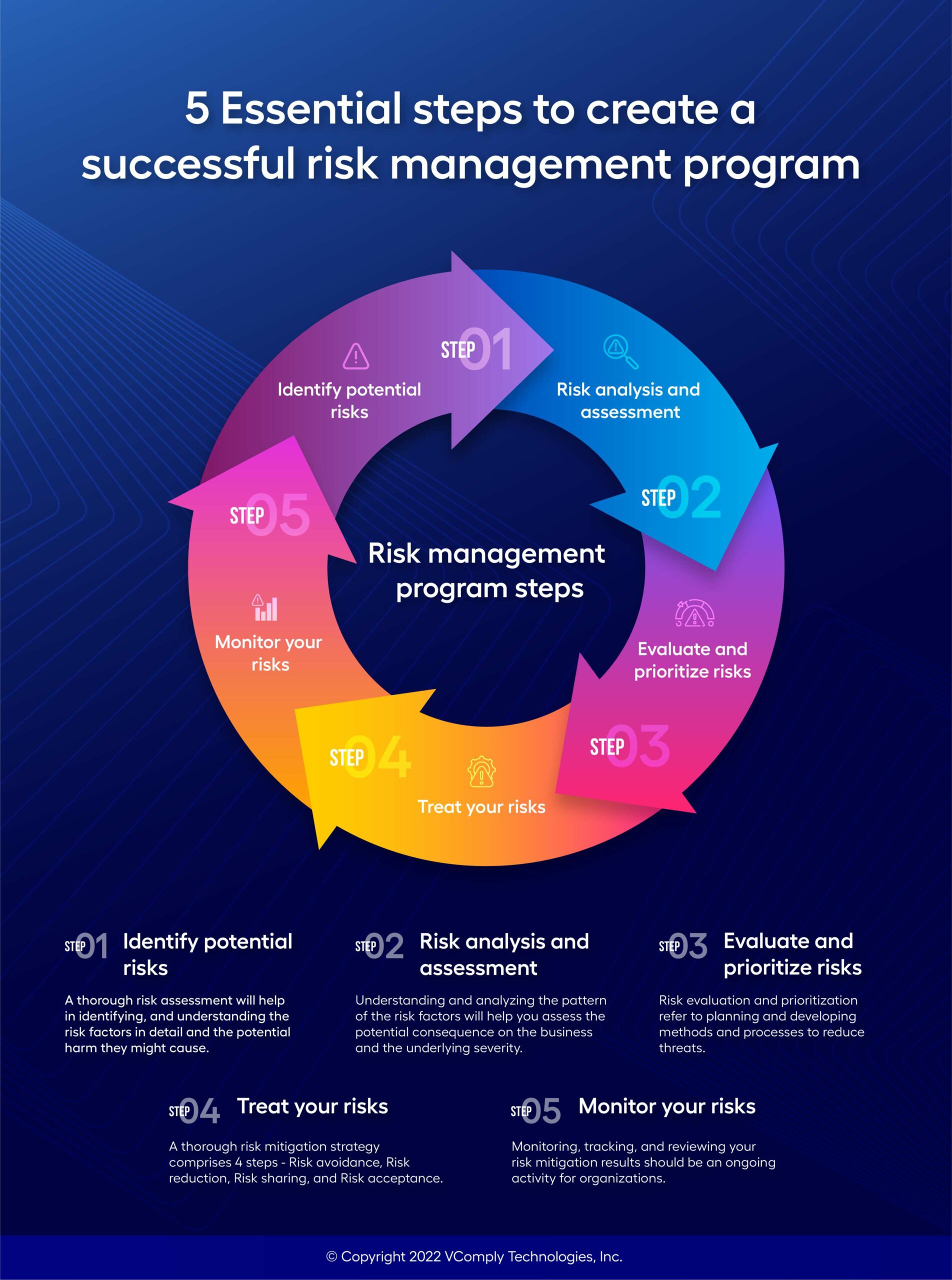5 Steps to Building an Effective Risk Management Program in Your Organization
The recent economic downturn, conflicts in Ukraine, rising inflation and interest rates, and the slumping of the global economy indicate that a sharper slowdown in the global economic activity is most likely inevitable.

Key takeaways (TL;DR)
- Discover why proactive risk management safeguards businesses from financial and operational threats.
- Learn to identify, assess, and prioritize risks to minimize losses effectively.
- Explore strategies to treat risks through avoidance, reduction, sharing, and acceptance.
- Get insights on continuous risk monitoring for improved decision-making and resilience.
- Understand how integrated risk management software streamlines processes and enhances collaboration.
The resulting foreseen events stemming from financial, strategic, legal, and security issues can cause havoc if organizations aren’t prepared in advance. Businesses around the world are concerned about the economy’s trajectory and are sure that elevated inflation shows few signs of abating.
In such a scenario, an effective risk management framework helps companies ensure business continuity even in the worst of times and mitigate the loss. Depending upon the preparedness of an organization, the impact can be a minor temporary setback or a major catastrophe causing heavy financial losses causing the closure of the business.
Such uncertainties make it even more important for organizations to understand the importance of risk assessment. To safeguard your organization against unforeseen and adverse events, a risk management program becomes inevitable.
Importance of risk management program
In this VUCA world (Volatility, Uncertainty, Complexity, Ambiguity), risk can arise from literally anywhere. If we only talk about cyber security risks, which are constantly on the rise over the last few years and have cost a fortune to organizations. As per a recent report by Verizon, cybercrime alone cost U.S. businesses around $6.9 billion in 2021, and only 43% of businesses feel financially prepared to face a cyber-attack in 2022.
A risk program can be defined as setting up immunity for the organizations to malevolent and unexpected events. The risk management framework defines the entire systematic and methodical process of identification, in-depth assessment, and control of strategic, legal, financial, and security risks targeted for an organization’s revenue and business operation. Threats such as legal issues, strategic errors, natural disasters, financial instability, or even security concerns can appear at any level.
A step-by-step, clearly laid out risk management program can mitigate the damage that might get caused if an event catches the organization off guard. Not only this, it has intrinsic benefits as well – this lays down a clear path for the organization to follow and as vivid as it would be, reduces the inherent uncertainty to a great level.
With the help of risk management tools and a consistent, systemic, and integrated approach to risk management, organizations can identify, and assess the risk factors threatening the organization’s stability by any means and take necessary precautionary steps to reduce the momentum and magnitude of the risk factors.
Let’s take a highly relevant example. An organization would not be able to withhold the next covid level pandemic breakout globally, but can ensure safety and business continuity in the organization by focusing on remote work, constraining the pandemic spread within the organization, and prepping the infrastructure setup.
Why are organizations investing in a risk management framework?
A full-proof, risk management framework works as a catalyst for an organization’s continuous business momentum and growth on a multitude of levels.
The benefits of a risk management framework for an organization are:
#1. Enhanced accountability
From structuring and revamping the process, and training the employees, to setting up infrastructure, an organization prepares itself for any unpredictable events in advance.
Although we have no control over the external forces, everyone in the organization is prepared to counter the risks since they are already anticipated.
#2. Better communication
Restricted siloed approach works as a deterrent to an extensive risk management program. As every team becomes accountable to prepare themselves as a whole, the communication among teams improves significantly and is multifold to tackle any imminent challenge and threats.
#3. Swift decision-making process
With an extensive, data-driven risk management process in place, the decision-making process becomes easier and swift. The management has access to the data in real-time, which is generated in minutes rather than days, and can leverage this information to drive the organization forward while taking proactive measures toward success.
#4. Board’s involvement
To enhance risk management, board members need active participation. With the increasing complexity of risk management, board members should ensure that their organization is capable of effectively identifying, mitigating, managing, and predicting new threats. In short, with a risk management framework in place, board members become more proactive to keep pace with disruption and maintain their strategic advantage.
#5. Thorough understanding of business realities
Amid the current uncertainties, risk management translates to strengthening resilience and creating sustainable value. It comprises an accurate projection and forecasting of risk factors, a complete evaluation of different types of risks, and even a thorough understanding of the impact of the risk factors on the business operations, finances, customers, and other stakeholders.
Now that you know the importance of risk management, let’s look at the 5 critical steps required to create a successful risk management plan.
5 Essential steps to create a successful risk management program
Step 1: Identify potential risks
The first step of risk identification involves identifying threats to an organization, its operations and the workforce. From an organization standpoint, it is imperative that the organization takes into account all potential and severe risk factors stemming from – legal, financial, security, natural calamities, fraud, single point of failure, and many more.
A thorough risk assessment will help in identifying, and understanding the risk factors in detail and the potential harm they might cause.
Two areas you need to focus on are:
- Involve your team members – include them as rightful participants and ensure that they put their voices forth so that everyone can sync with the process in case of any such event.
- Create a risk log/register to log all the potential risk factors meaning from the current business operations and ongoing projects. It serves as a full-fledged database of all the risk factors and also as a reference point for past ones.
For instance, identifying risks entails assessing IT security threats, accidents, and other potential events that could disrupt business operations.
Step 2: Risk analysis and assessment
Once the potential risks have been identified, you need to perform a thorough and meticulous risk analysis and assessment. Compare the magnitude of each risk and rank them based on their prominence and consequence. As every threat is unique and varies greatly on the basis of severity and type, you need to understand and determine the threat’s scope and potential disruption level.
The questions to be asked for assessment are:
- How severe are the treats?
- Are the risks one-time or repetitive in nature?
- What is the consequence if risks aren’t mitigated?
- What damage the company has to endure in case of such an event?
Understanding the pattern of the risk factors associated with your organization will help you assess the potential consequence on the business at different levels and the underlying severity.

Step 3: Evaluate and prioritize risks
Risk evaluation and prioritization refer to planning and developing methods and processes to reduce threats. This involves actions to deal with issues and the subsequent effects of those issues.
What’s important to know is that risk management is a continuous process that adapts and evolves over time. Continuous evaluation and monitoring ensure maximum coverage of both known and unknown risks.
Step 4: Treat your risks
Risk treatment is one of the most crucial steps in the risk management process. You should first zero in your focus on high-priority risk factors to resolve or mitigate them and then go for the next ones based on the severity.
A thorough risk mitigation strategy comprises 4 steps:
- Risk avoidance – Avoid the risk by any means necessary. Even if you have to stop an ongoing business activity for it.
- Risk reduction – Take preventive measures to stop the potential risks from surfacing in real-time, such as instructing your employees to not click on unsolicited emails to thwart phishing attacks.
- Risk sharing – Mitigate your risk with insurance covers or by involving 3rd parties so in case of any adverse event, the responsibility is shared.
- Risk acceptance – You need to accept certain cases, if the threat takes place, the organization will accept the consequences and be prepared to deal with it by having a contingency plan.
Step 5: Monitor your risks
Risks are constantly evolving and so are your risk mitigation strategies. Monitoring, tracking, and reviewing your risk mitigation results is an ongoing activity for organizations. In case any strategy doesn’t fit anymore or is outdated, it has to be modified according to the risk factor.
Rather than reactive measures, taking data-driven proactive measures using integrated risk management software can help identify, assess, mitigate, and monitor business risks. Thorough and rigorous monitoring is an integral part of it.
An integrated risk management software can mitigate hefty penalties and business disruptions
VComply is a leading cloud-based integrated risk management software that helps streamline organizations’ compliance and risk management programs with a strong focus on collaboration.
The key benefits of using the integrated risk management platform VComply are:
- Comprehensive risk visibility – Identify and view the risks impacting your business, monitor the key risk indicators, and prioritize the risk management process.

- Measurable outcomes – Eliminate bottlenecks, measure the impact of controls, and reduce your compliance costs.

- Reduced liabilities – Proactive identification and management of risks leads to paying fewer fines, penalties, and reduced liabilities.

- Improved collaboration – A centralized risk management workspace allows stakeholders and business owners to risk assessment workshops. The real-time insights help to identify critical risks.

Wrapping up
While the path to growth remains uncertain, what we know for sure is that new kinds of risks will keep emerging. Companies that can reframe their approach to risk management will be in a stronger position to reinvent themselves for a sustained future.
Your risk management framework needs to deliver real-time, granular, and holistic insights, link data from multiple sources, interpret the insights gained, and act on them quickly. An integrated risk management software transforms the speed at which you can spot and fix risks.
See why VComply stands out as a G2 high performer in Compliance and Risk Management. Request your demo to see how it can drive your compliance initiatives.
